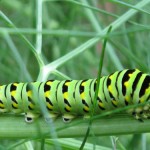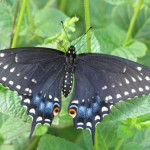 |
 |
 |
The Black Swallowtail (Papilio polyxenes) butterfly is commonly found in fields, gardens, and open spaces in the Northeastern United States. Above, left: The body of the fully developed caterpillar with its bold, bright bands of yellow, green, and black, is conspicuous against the feathery foliage of the fennel which is its favorite food; center: a female Black Swallowtail at rest on a salvia in Cuxa garden, as seen from above; right: the same butterfly seen in profile with its wings folded upward. Photographs by Corey Eilhardt.
We found several large, boldly marked caterpillars feeding on a stand of fennel (Foeniculum vulgare) in Bonnefont garden last month. We left them undisturbed, knowing from past experience that they would grow up to be beautiful eastern Black Swallowtail butterflies. Papilio polyxenes asterius is the sole eastern representative of the “Old World Swallowtail Group” of butterflies, most of whose members are western. (For more on the life cycle of this species, including a slide show on the morphing of the caterpillar into an adult swallowtail, visit www.pbase.com/. For more on fennel and its uses in the Middle Ages, see “Honoring Fennel,” September 25, 2008.)
These butterflies have co-evolved with members of the Apiaceae, or parsley family, including fennel, parsley, dill, caraway, celery, carrot, and Queen Anne’s lace. These plants produce furanocoumarins, toxic chemicals that provide a defense against consumption by insects or mammals. Black Swallowtails have specialized enzymes that permit them to incorporate these toxins into their own defense systems without harm to themselves. In conjunction with sunlight, these strong-smelling and -tasting plant toxins can provoke photodermatitis, as well as damage the DNA of herbivores who ingest them. The foul smell and taste of the phytotoxins repel predators. The Black Swallowtail caterpillar makes use of a special gland called an osmeterium to emit a stink when threatened.
While swallowtail larvae prefer host plants in the parsley family, they also feed on rue (Ruta graveolens), a notoriously pungent and bitter herb, contact with which can cause photodermatitis in sensitive individuals. Although rue grows very close by, we’ve never observed the caterpillars of Papilio polyxenes feeding on any plant other than the fennel, although many members of the same botanical family grow throughout the gardens.
???Deirdre Larkin
Source:
Cech, Rick and Guy Tudor. Butterflies of the East Coast: An Observer’s Guide. Princeton: Princeton University Press, 2005.
Tags: Apiaceae, Black Swallowtail, caterpillar, Fennel, Foeniculum vulgare, furanocoumarins, osmeterium, Papilio polyxenes, photodermatitis, phytotoxins, Ruta graveolens

September 16, 2010 at 12:24 pm
The swallowtails were amazing for us as well!